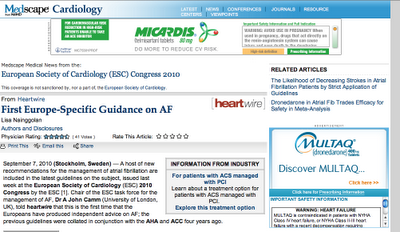September 21st, 2010
See Everything
John Mandrola, MD, FACC
John Mandrola is a cardiac electrophysiologist and blogger on matters medical and general. Here is a recent post from his blog Dr John M.
Do you see anything wrong with this picture?
(Hint: see the right column)
I guess the European electrophysiologists couldn’t wait for us in North America. They have published their own 54,000 word Euro-specific guidance on AF management. It is certainly true that atrial fibrillation management guidelines needed an update; the last comprehensive revision was in 2006. Much has changed in AF therapy, including the expanded role of catheter ablation and the soon-to-be warfarin substitutes. There are some neat new topics in this revision: a novel symptom score for AF, refinement of the CHADS2 scale for predicting stroke risk (in anticipation of new anticoagulants), and an expanded role of catheter ablation. All of these are welcome, fairly uncontroversial additions. The more contentious issue is the role of “newer anti-arrhythmic agents.”
Well, that could only mean one thing . . . yes, you guessed . . . dronedarone.
From Dr J Camm (a prominent British professor and a paid consultant for Sanofi), as quoted in a Heartwire article, we hear:
For rhythm control, the guidelines incorporate the new antiarrhythmic drug dronedarone, which was approved by the European Medicines Agency at the end of last year, into the recommendations. “We’re saying, from a benefit/risk point of view, that dronedarone is widely applicable.”
“Widely applicable,” he says? Of dronedarone? Hmm.
There are ample dronedarone data in the literature. As treatment forAF, it is touted for its safety and its reduction of hospitalizations. But not all the findings are so flattering. Especially, these less-than-striking data on its efficacy for suppressing AF. The selective emphasis in the reporting of dronedarone trials is chronicled here, on Cardiobrief.
The catch with dronedarone is that patients with symptomatic AF look to us to help relieve their symptoms. Favorable statistics are one thing — dronedarone researchers have plenty of data to publish articles. However, in the real world, where AF patients consider their treatment successful when their AF stops, lack of AF-suppression is a challenging hurdle to overcome. But they will try, with paid professors and banner ads on purportedly information-only websites.
Dronedarone’s lack of efficacy will sort itself out in time. It will find its limited role. But until then, the banner ads and proclamations from the universities will likely continue.
I was taught in medical school to look around on entering a patient’s room, to take in everything — the sights and smells, the family, the monitors, and even the patient’s reading material. Much can be learned from the background, the sidelines. This is also good advice when reading information on the internet. Take in everything, including a look at what’s on the right of the page to see who is paying to promulgate the information.
Eyes open.


Excellent cardioexchange from Dr,John Mandrola,! Such comments make the debates lively and transparent.
Yes, commercial insinuations in main stream guidelines is part of the medical literature and we have learnt live with that.
It is the price we give for living in the so called knowledge society !
Please read the related blog
http://drsvenkatesan.wordpress.com/2010/09/17/humour-based-cardiology-dronidarone-when-inefficiency-becomes-an-advantage/